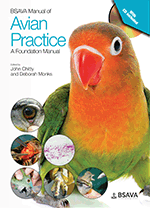
Full text loading...

Lower respiratory tract disease (LRTD) is common in parrots, raptors and passerines. However, it can be difficult to recognize because presenting signs are often non-specific and frequently not obviously respiratory. This chapter deals with the clinical signs, therapeutic approach, diagnostic techniques and indications for diseases involving the lungs and air sacs. Case examples: Glossy Black Cockatoo with clinical chlamydiosis; Green-winged Macaw with aspergillosis and Escherichia coli infection; Thin Cockatiel with dyspnoea; Foreign body ingestion in an African Grey Parrot.
Lower respiratory tract disease, Page 1 of 1
< Previous page | Next page > /docserver/preview/fulltext/10.22233/9781910443323/9781910443323.22-1.gif

Full text loading...









